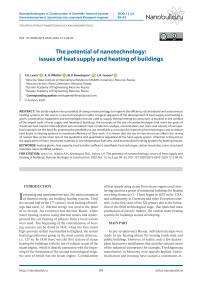The potential of nanotechnology: issues of heat supply and heating of buildings
Автор: Levin Y.A., Nikitin A.A., Konotopov M.V., Ivanov L.A.
Журнал: Nanotechnologies in Construction: A Scientific Internet-Journal @nanobuild-en
Рубрика: Application of nanotechnologies and nanomaterials
Статья в выпуске: 2 Vol.12, 2020 года.
Бесплатный доступ
The article explores the possibility of using nanotechnology to improve the efficiency of centralized and autonomous heating systems on the way to a new technological model. A logical sequence of the development of heat supply and heating is given, conservative equipment and technologies that are used to supply thermal energy to consumers is marked. In the context of the urgent tasks of heat supply and heating of buildings, the concepts of the use of nanotechnologies that meet the goals of maximum heat transfer intensification are considered. Heat conduction analysis, concentration, size, mass and velocity of nanoparticles assesses are the basis for assessing the possibility to use nanofluids as a coolant for improving heat exchangers and to reduce heat losses in heating systems to maximize efficiency of their work. It is shown that the use of nanostructures affects the saving of coolant flow as the main task of the qualitative and quantitative regulation of the heat supply system. Attention is focused on the application of nano-structured materials in low-temperature fuel cells used decentralized heating systems for heating houses.
Heating plants, heat capacity, heat transfer coefficient, nanofluids, heat exchanger, carbon nanotubes, nano-structured materials, nano-modified surfaces
Короткий адрес: https://sciup.org/142227421
IDR: 142227421 | DOI: 10.15828/2075-8545-2020-12-2-89-93
Текст научной статьи The potential of nanotechnology: issues of heat supply and heating of buildings
Список литературы The potential of nanotechnology: issues of heat supply and heating of buildings
- Activation of energy saving and energy efficiency improvement in the conditions of innovative modernization of the Russian economy (2017). Editor: A.N. Melnik. Kazan: Kazan university Publ., 268 p. (In Russian).
- Ametistov E.V., Dmitriev A.S. (2008) Nanoenergy-potential opportunities and prospects. Energoekspert. No. 2. P. 86. (In Russian).
- Dmitriev A.S. (2014) Methods for converting low-potential heat based. Proceedings of the Sixth Russian national conference on heat exchange. P. 1–2. (In Russian).
- Kozin V.E., Levina T.A., Markov A.P., et al. (1980) Heat supply: textbook. Moscow: Higher school. 407p. (In Russian).
- Krichevskij G.E. (2015) Nanotechnology in modern energy and in the energy of the future. Available at: http://www.nanonewsnet. ru/articles/nanotekhnologii-v-sovremennoi-energetike-v-energetike-budushchego (In Russian).
- Kuzma-Kichta Yu.A., Lavrikov A.V., Shustov M.V., et al. (2014). Investigation of heat transfer intensification on a surface wit micro-and nanorelief. Heat power engineering. Vol. 61. № 3. P. 35. (In Russian).
- Levin Y. A., Pavlov A.O. (2017) Innovative and technological development: theoretical basis and applied aspects: monograph. Ruscience Publ. 148 p. (In Russian).
- Lukashin A.V., Eliseev A.A. (2007). Applications of functional nanomaterials Part 1: MEMS, NEMS, nanoelectronics. Moscow: Moscow state University n.a. M.V. Lomonosov. 45 p. (In Russian).
- Nanotechnology as a key factor of the new technological order in the economy (2009). Editors: S.Y. Glazev & V.V. Haritonov. Moscow, Trovant Publ., 304 p. (In Russian).
- Rudyak V.Y, Minakov A.V, Pryazhnikov M.I. Thermophysical properties of nanofluids and similarity criteria (2016). Letters to the Journal of technical. Vol. 42. № 24, P. 9–16. (In Russian).
- Surtaev A.S., Serdyukov V.S., Pavlenko A.N. (2017). Nanotechnology in thermal physics: heat transfer. Russian nanotechnologies. Vol. 11. № 11–12. P. 18. (In Russian).
- Terekhov V.I., Kalinina, S.V., Lemanov V.V. (2010) Mechanism of heat transfer in nanofluids: current state of the problem (review) part 2. Convective heat transfer. Thermophysics and Aeromechanics. Vol. 17. 2. P. 173–188. (In Russian).
- Trubicyna G.N., Frolikova V.S., Barzenkova V.V. (2016) Intensification of heat and mass transfer processes in TGV systems due to the use of nanofluids. Actual problems of modern science, technology and education. Vol. 2. P. 78–81. (In Russian).
- Physical basis and industrial application of heat transfer intensification: monograph (2009) Popov I.A., Mahyanov H.M., Gureev V.M. Kazan: Center for innovative technologies. 560 p. (In Russian).
- Yаroslavcev A.B., Dobrovolskiy Y.A., Shaglaeva N.S., et al. (2012) Nanostructured materials for low- temperature fuel cells. Advances in chemistry. Vol. 81. № 3, P. 191–220. (In Russian).
- Attinger D., et al. (2014). Surface engineering for phase change heat transfer: A review. MRS Energy & Sustainability. Vol. 1. P. 4. DOI 10/1557/mre2014.9.
- Girfanova V.V., Gevorgyan A.G., Velkin V.I. (2018) The analysis of possibility in nanofluid application as the heat carrier for increase in efficiency of heat supply systems. International Journal of Professional Science. № 3. P. 35–38.
- Kim S., et al. (2010). Effects of nano-fluid and surfaces with nano structure on the increase of CHF. Experimental Thermal and Fluid Science. V. 34. № 4. P. 487.
- Kosacki I., Rouleau C.M., Becher P.F., et al (2005) Nanoscale effects on the ionic conductivity in highly textured YSZ thin films. Solid State Ionics. Vol. 176. № 13–14. P. 1319–1326.
- Prakash S., Yeom J. (2014) Nanofluidics and Microfluidics: Systems and Applications. William Andrew Publishing, Norwich, N.Y., 312 p. DOI: 10.1016/B978-1-4377-4469-9.00001-9.
- Wang X.Q., Mujumdar A.S. (2007) Heat transfer characteristics of nanofluids: a review. International J. of Thermal Sciences. V. 46. № 1. P. 1.
- Eastman J. A., et al. (1998) Enhanced thermal conductivity through the development of nanofluids. Materials Research Society. Boston, Fall Meeting. P. 3–11.
- Wang Xu.X., Choi S.U. (1999) Thermal conductivity of nanoparticle fluid mixture. Thermophys. Heat Trans. Vol. 13. № 4. P. 474.


